BSBFIM601 Financial Management: Budgeting, Forecasting & Reporting
VerifiedAdded on 2023/03/23
|27
|6780
|49
Portfolio
AI Summary
This portfolio assessment for BSBFIM601 Manage Finances covers key aspects of financial management including reviewing financial data, undertaking research on profit and loss, analyzing cash flow trends, and ensuring compliance with statutory requirements. It involves preparing budgets, managing risks, and revising budgets as needed, along with maintaining audit trails. The assessment also focuses on ensuring the clarity and conformity of financial reports, identifying significant issues, and preparing recommendations for financial viability. It includes written responses and a project on a simulated work organization (Australian Hardware), along with a presentation involving financial analysis.
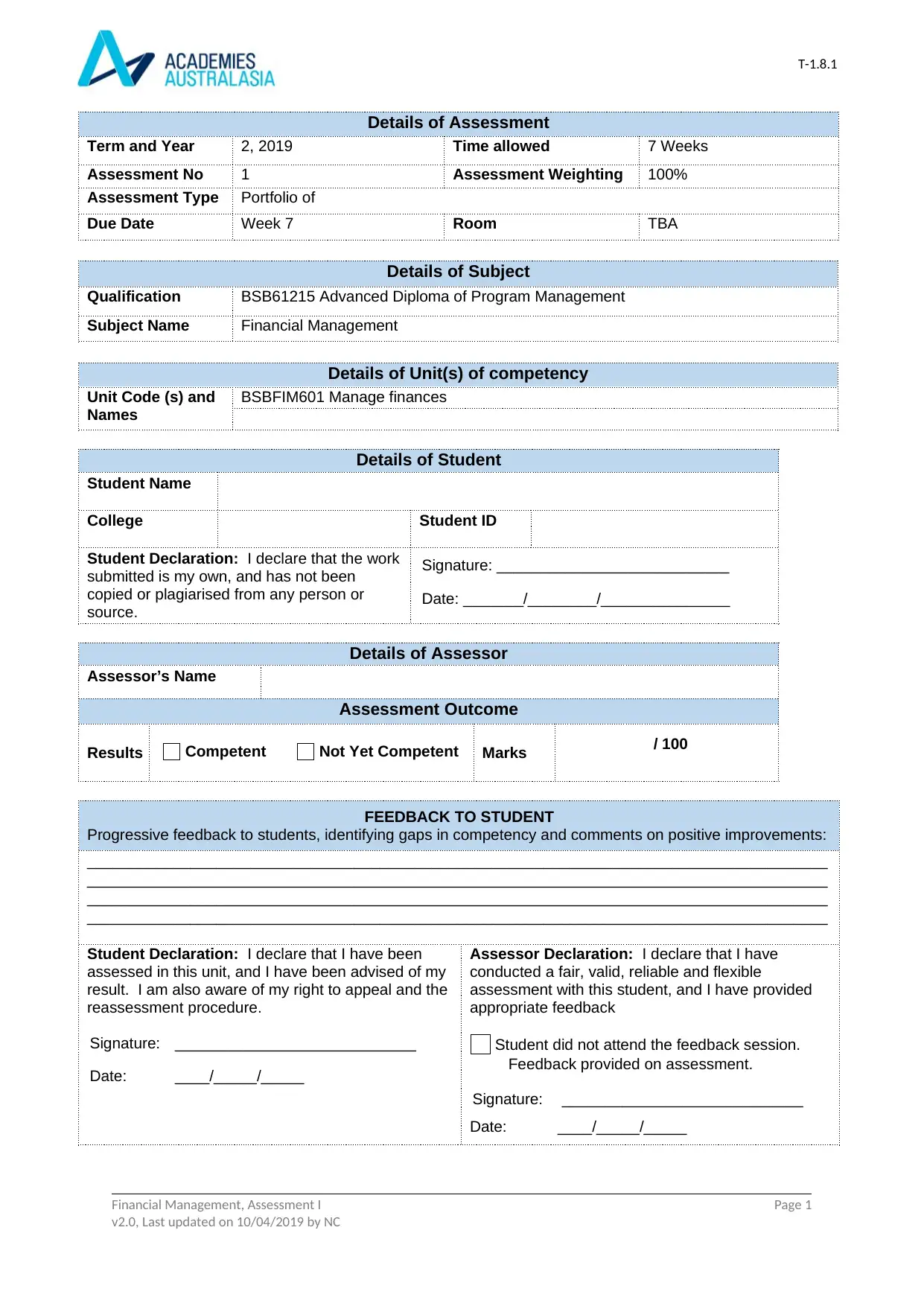
T-1.8.1
Details of Assessment
Term and Year 2, 2019 Time allowed 7 Weeks
Assessment No 1 Assessment Weighting 100%
Assessment Type Portfolio of
Due Date Week 7 Room TBA
Details of Subject
Qualification BSB61215 Advanced Diploma of Program Management
Subject Name Financial Management
Details of Unit(s) of competency
Unit Code (s) and
Names
BSBFIM601 Manage finances
Details of Student
Student Name
College Student ID
Student Declaration: I declare that the work
submitted is my own, and has not been
copied or plagiarised from any person or
source.
Signature: ___________________________
Date: _______/________/_______________
Details of Assessor
Assessor’s Name
Assessment Outcome
Results Competent Not Yet Competent Marks / 100
FEEDBACK TO STUDENT
Progressive feedback to students, identifying gaps in competency and comments on positive improvements:
______________________________________________________________________________________
______________________________________________________________________________________
______________________________________________________________________________________
______________________________________________________________________________________
Student Declaration: I declare that I have been
assessed in this unit, and I have been advised of my
result. I am also aware of my right to appeal and the
reassessment procedure.
Signature: ____________________________
Date: ____/_____/_____
Assessor Declaration: I declare that I have
conducted a fair, valid, reliable and flexible
assessment with this student, and I have provided
appropriate feedback
Student did not attend the feedback session.
Feedback provided on assessment.
Signature: ____________________________
Date: ____/_____/_____
Financial Management, Assessment I Page 1
v2.0, Last updated on 10/04/2019 by NC
Details of Assessment
Term and Year 2, 2019 Time allowed 7 Weeks
Assessment No 1 Assessment Weighting 100%
Assessment Type Portfolio of
Due Date Week 7 Room TBA
Details of Subject
Qualification BSB61215 Advanced Diploma of Program Management
Subject Name Financial Management
Details of Unit(s) of competency
Unit Code (s) and
Names
BSBFIM601 Manage finances
Details of Student
Student Name
College Student ID
Student Declaration: I declare that the work
submitted is my own, and has not been
copied or plagiarised from any person or
source.
Signature: ___________________________
Date: _______/________/_______________
Details of Assessor
Assessor’s Name
Assessment Outcome
Results Competent Not Yet Competent Marks / 100
FEEDBACK TO STUDENT
Progressive feedback to students, identifying gaps in competency and comments on positive improvements:
______________________________________________________________________________________
______________________________________________________________________________________
______________________________________________________________________________________
______________________________________________________________________________________
Student Declaration: I declare that I have been
assessed in this unit, and I have been advised of my
result. I am also aware of my right to appeal and the
reassessment procedure.
Signature: ____________________________
Date: ____/_____/_____
Assessor Declaration: I declare that I have
conducted a fair, valid, reliable and flexible
assessment with this student, and I have provided
appropriate feedback
Student did not attend the feedback session.
Feedback provided on assessment.
Signature: ____________________________
Date: ____/_____/_____
Financial Management, Assessment I Page 1
v2.0, Last updated on 10/04/2019 by NC
Paraphrase This Document
Need a fresh take? Get an instant paraphrase of this document with our AI Paraphraser
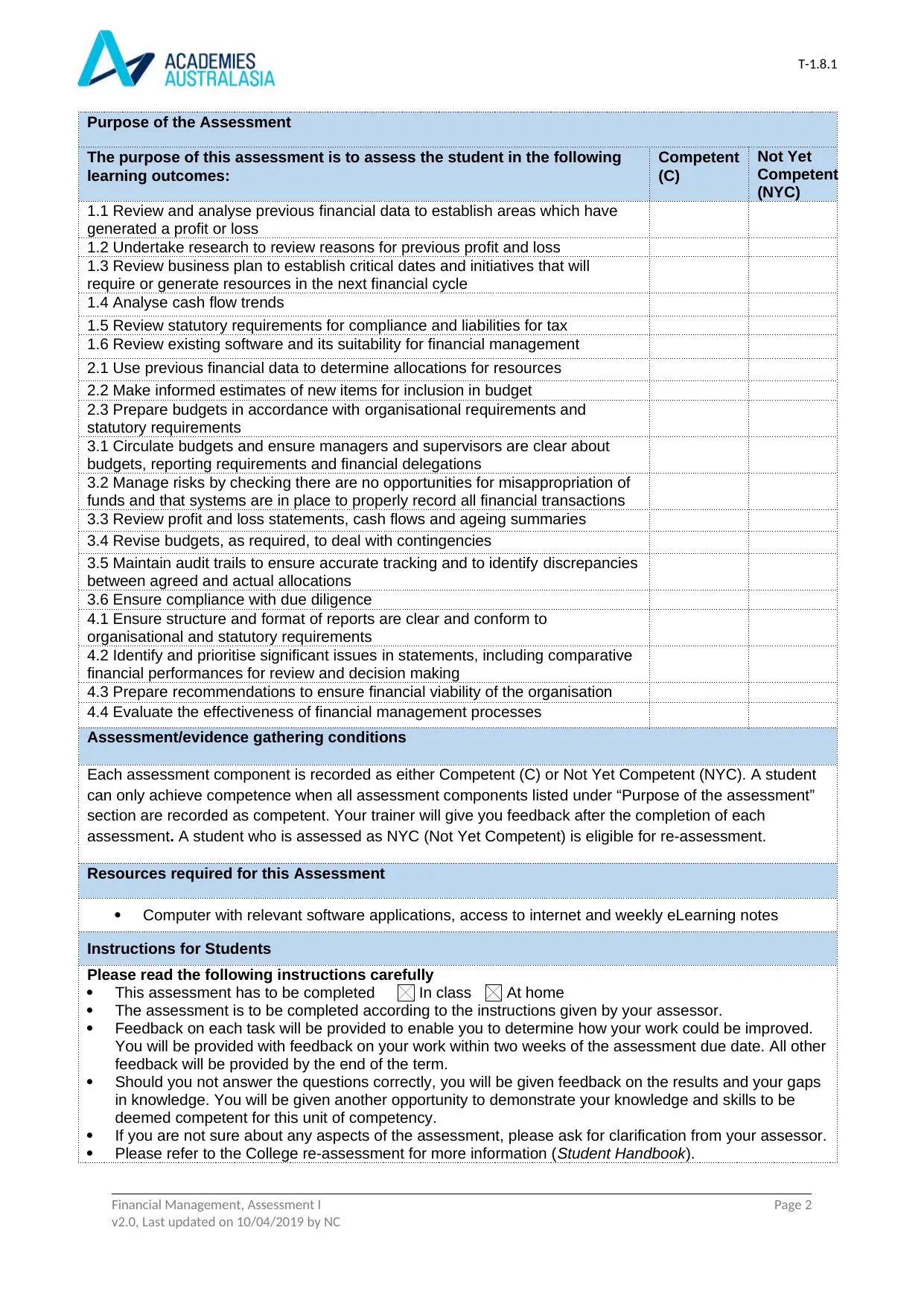
T-1.8.1
Purpose of the Assessment
The purpose of this assessment is to assess the student in the following
learning outcomes:
Competent
(C)
Not Yet
Competent
(NYC)
1.1 Review and analyse previous financial data to establish areas which have
generated a profit or loss
1.2 Undertake research to review reasons for previous profit and loss
1.3 Review business plan to establish critical dates and initiatives that will
require or generate resources in the next financial cycle
1.4 Analyse cash flow trends
1.5 Review statutory requirements for compliance and liabilities for tax
1.6 Review existing software and its suitability for financial management
2.1 Use previous financial data to determine allocations for resources
2.2 Make informed estimates of new items for inclusion in budget
2.3 Prepare budgets in accordance with organisational requirements and
statutory requirements
3.1 Circulate budgets and ensure managers and supervisors are clear about
budgets, reporting requirements and financial delegations
3.2 Manage risks by checking there are no opportunities for misappropriation of
funds and that systems are in place to properly record all financial transactions
3.3 Review profit and loss statements, cash flows and ageing summaries
3.4 Revise budgets, as required, to deal with contingencies
3.5 Maintain audit trails to ensure accurate tracking and to identify discrepancies
between agreed and actual allocations
3.6 Ensure compliance with due diligence
4.1 Ensure structure and format of reports are clear and conform to
organisational and statutory requirements
4.2 Identify and prioritise significant issues in statements, including comparative
financial performances for review and decision making
4.3 Prepare recommendations to ensure financial viability of the organisation
4.4 Evaluate the effectiveness of financial management processes
Assessment/evidence gathering conditions
Each assessment component is recorded as either Competent (C) or Not Yet Competent (NYC). A student
can only achieve competence when all assessment components listed under “Purpose of the assessment”
section are recorded as competent. Your trainer will give you feedback after the completion of each
assessment. A student who is assessed as NYC (Not Yet Competent) is eligible for re-assessment.
Resources required for this Assessment
Computer with relevant software applications, access to internet and weekly eLearning notes
Instructions for Students
Please read the following instructions carefully
This assessment has to be completed In class At home
The assessment is to be completed according to the instructions given by your assessor.
Feedback on each task will be provided to enable you to determine how your work could be improved.
You will be provided with feedback on your work within two weeks of the assessment due date. All other
feedback will be provided by the end of the term.
Should you not answer the questions correctly, you will be given feedback on the results and your gaps
in knowledge. You will be given another opportunity to demonstrate your knowledge and skills to be
deemed competent for this unit of competency.
If you are not sure about any aspects of the assessment, please ask for clarification from your assessor.
Please refer to the College re-assessment for more information (Student Handbook).
Financial Management, Assessment I Page 2
v2.0, Last updated on 10/04/2019 by NC
Purpose of the Assessment
The purpose of this assessment is to assess the student in the following
learning outcomes:
Competent
(C)
Not Yet
Competent
(NYC)
1.1 Review and analyse previous financial data to establish areas which have
generated a profit or loss
1.2 Undertake research to review reasons for previous profit and loss
1.3 Review business plan to establish critical dates and initiatives that will
require or generate resources in the next financial cycle
1.4 Analyse cash flow trends
1.5 Review statutory requirements for compliance and liabilities for tax
1.6 Review existing software and its suitability for financial management
2.1 Use previous financial data to determine allocations for resources
2.2 Make informed estimates of new items for inclusion in budget
2.3 Prepare budgets in accordance with organisational requirements and
statutory requirements
3.1 Circulate budgets and ensure managers and supervisors are clear about
budgets, reporting requirements and financial delegations
3.2 Manage risks by checking there are no opportunities for misappropriation of
funds and that systems are in place to properly record all financial transactions
3.3 Review profit and loss statements, cash flows and ageing summaries
3.4 Revise budgets, as required, to deal with contingencies
3.5 Maintain audit trails to ensure accurate tracking and to identify discrepancies
between agreed and actual allocations
3.6 Ensure compliance with due diligence
4.1 Ensure structure and format of reports are clear and conform to
organisational and statutory requirements
4.2 Identify and prioritise significant issues in statements, including comparative
financial performances for review and decision making
4.3 Prepare recommendations to ensure financial viability of the organisation
4.4 Evaluate the effectiveness of financial management processes
Assessment/evidence gathering conditions
Each assessment component is recorded as either Competent (C) or Not Yet Competent (NYC). A student
can only achieve competence when all assessment components listed under “Purpose of the assessment”
section are recorded as competent. Your trainer will give you feedback after the completion of each
assessment. A student who is assessed as NYC (Not Yet Competent) is eligible for re-assessment.
Resources required for this Assessment
Computer with relevant software applications, access to internet and weekly eLearning notes
Instructions for Students
Please read the following instructions carefully
This assessment has to be completed In class At home
The assessment is to be completed according to the instructions given by your assessor.
Feedback on each task will be provided to enable you to determine how your work could be improved.
You will be provided with feedback on your work within two weeks of the assessment due date. All other
feedback will be provided by the end of the term.
Should you not answer the questions correctly, you will be given feedback on the results and your gaps
in knowledge. You will be given another opportunity to demonstrate your knowledge and skills to be
deemed competent for this unit of competency.
If you are not sure about any aspects of the assessment, please ask for clarification from your assessor.
Please refer to the College re-assessment for more information (Student Handbook).
Financial Management, Assessment I Page 2
v2.0, Last updated on 10/04/2019 by NC
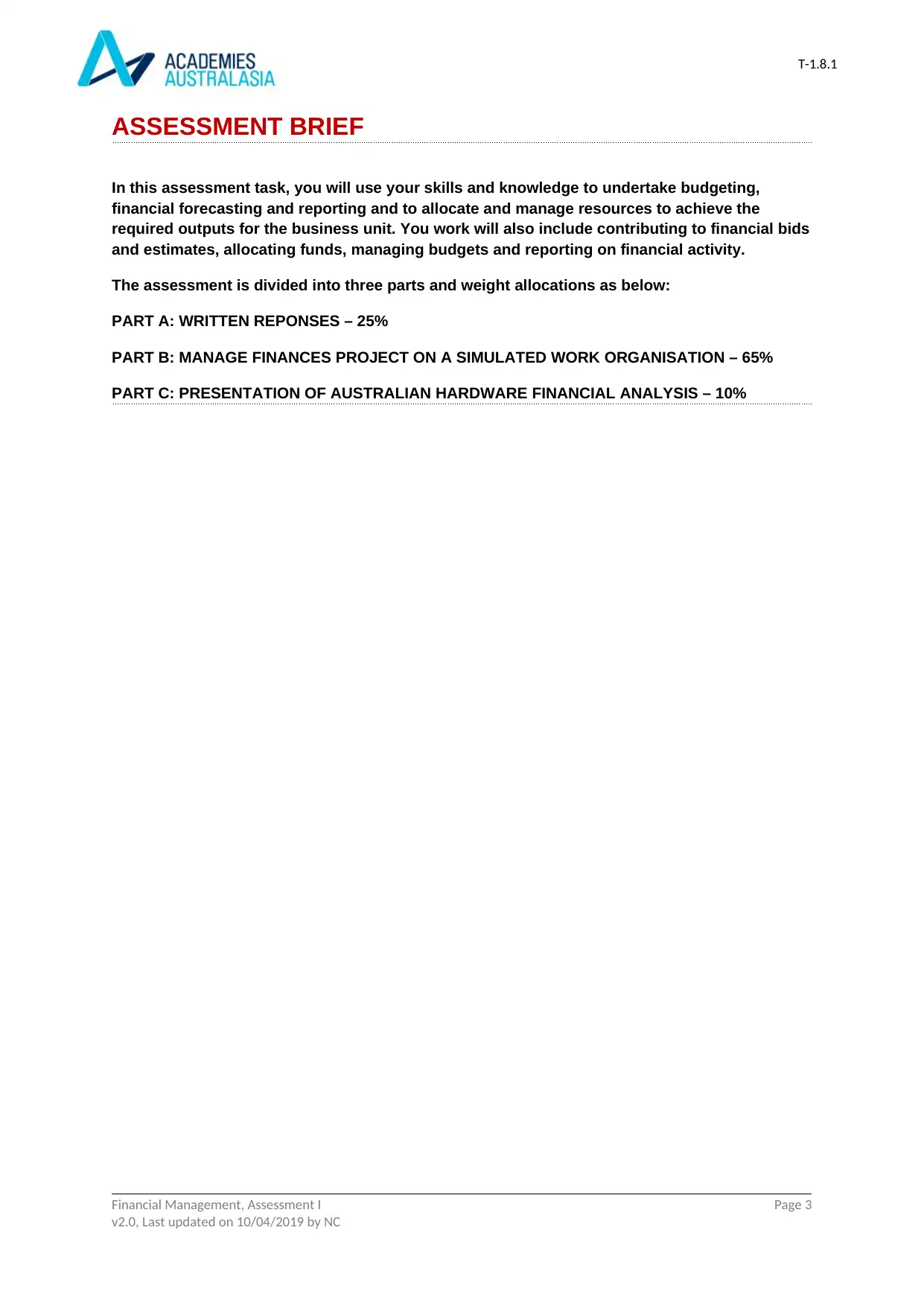
T-1.8.1
ASSESSMENT BRIEF
In this assessment task, you will use your skills and knowledge to undertake budgeting,
financial forecasting and reporting and to allocate and manage resources to achieve the
required outputs for the business unit. You work will also include contributing to financial bids
and estimates, allocating funds, managing budgets and reporting on financial activity.
The assessment is divided into three parts and weight allocations as below:
PART A: WRITTEN REPONSES – 25%
PART B: MANAGE FINANCES PROJECT ON A SIMULATED WORK ORGANISATION – 65%
PART C: PRESENTATION OF AUSTRALIAN HARDWARE FINANCIAL ANALYSIS – 10%
Financial Management, Assessment I Page 3
v2.0, Last updated on 10/04/2019 by NC
ASSESSMENT BRIEF
In this assessment task, you will use your skills and knowledge to undertake budgeting,
financial forecasting and reporting and to allocate and manage resources to achieve the
required outputs for the business unit. You work will also include contributing to financial bids
and estimates, allocating funds, managing budgets and reporting on financial activity.
The assessment is divided into three parts and weight allocations as below:
PART A: WRITTEN REPONSES – 25%
PART B: MANAGE FINANCES PROJECT ON A SIMULATED WORK ORGANISATION – 65%
PART C: PRESENTATION OF AUSTRALIAN HARDWARE FINANCIAL ANALYSIS – 10%
Financial Management, Assessment I Page 3
v2.0, Last updated on 10/04/2019 by NC
⊘ This is a preview!⊘
Do you want full access?
Subscribe today to unlock all pages.

Trusted by 1+ million students worldwide
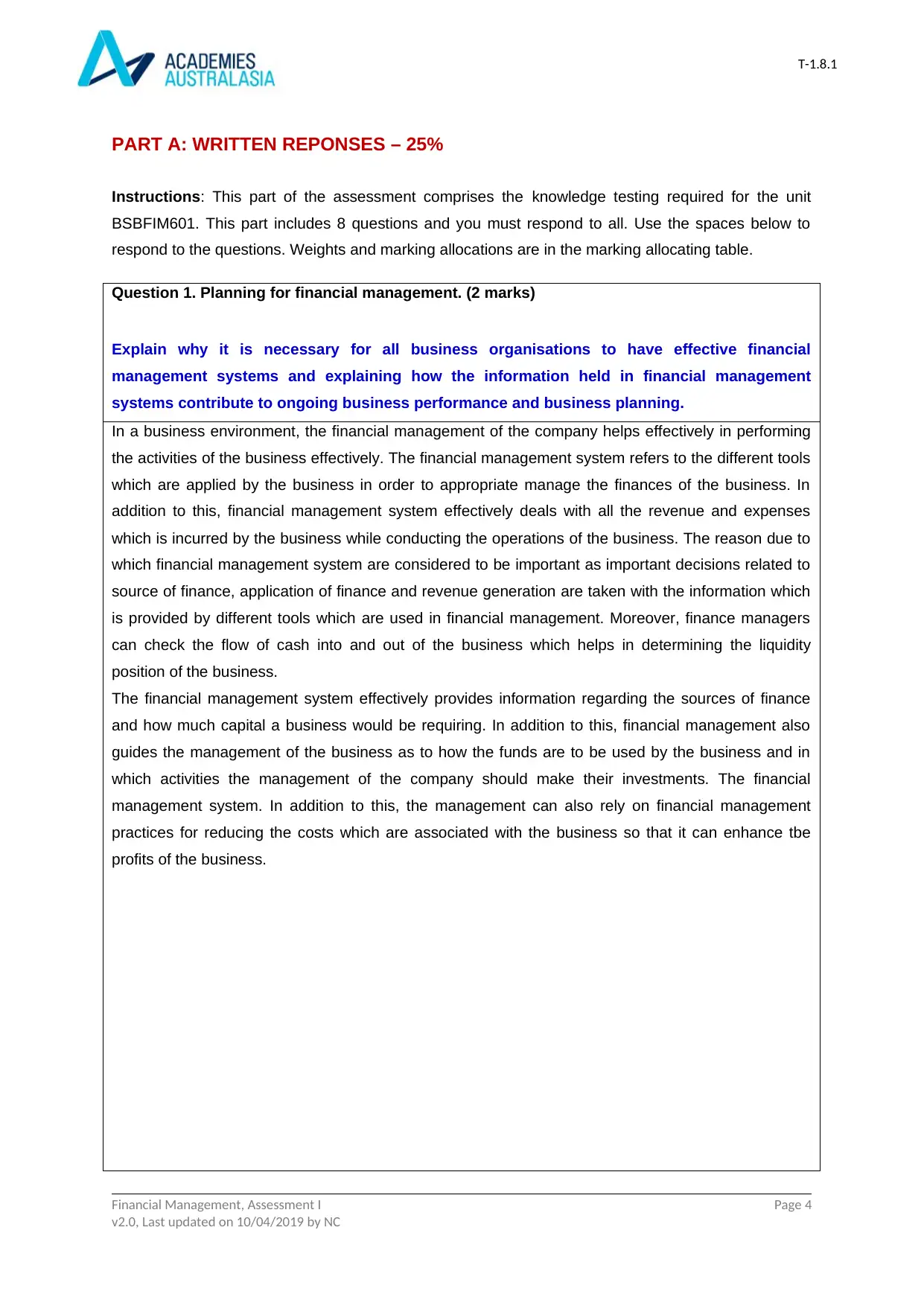
T-1.8.1
PART A: WRITTEN REPONSES – 25%
Instructions: This part of the assessment comprises the knowledge testing required for the unit
BSBFIM601. This part includes 8 questions and you must respond to all. Use the spaces below to
respond to the questions. Weights and marking allocations are in the marking allocating table.
Question 1. Planning for financial management. (2 marks)
Explain why it is necessary for all business organisations to have effective financial
management systems and explaining how the information held in financial management
systems contribute to ongoing business performance and business planning.
In a business environment, the financial management of the company helps effectively in performing
the activities of the business effectively. The financial management system refers to the different tools
which are applied by the business in order to appropriate manage the finances of the business. In
addition to this, financial management system effectively deals with all the revenue and expenses
which is incurred by the business while conducting the operations of the business. The reason due to
which financial management system are considered to be important as important decisions related to
source of finance, application of finance and revenue generation are taken with the information which
is provided by different tools which are used in financial management. Moreover, finance managers
can check the flow of cash into and out of the business which helps in determining the liquidity
position of the business.
The financial management system effectively provides information regarding the sources of finance
and how much capital a business would be requiring. In addition to this, financial management also
guides the management of the business as to how the funds are to be used by the business and in
which activities the management of the company should make their investments. The financial
management system. In addition to this, the management can also rely on financial management
practices for reducing the costs which are associated with the business so that it can enhance tbe
profits of the business.
Financial Management, Assessment I Page 4
v2.0, Last updated on 10/04/2019 by NC
PART A: WRITTEN REPONSES – 25%
Instructions: This part of the assessment comprises the knowledge testing required for the unit
BSBFIM601. This part includes 8 questions and you must respond to all. Use the spaces below to
respond to the questions. Weights and marking allocations are in the marking allocating table.
Question 1. Planning for financial management. (2 marks)
Explain why it is necessary for all business organisations to have effective financial
management systems and explaining how the information held in financial management
systems contribute to ongoing business performance and business planning.
In a business environment, the financial management of the company helps effectively in performing
the activities of the business effectively. The financial management system refers to the different tools
which are applied by the business in order to appropriate manage the finances of the business. In
addition to this, financial management system effectively deals with all the revenue and expenses
which is incurred by the business while conducting the operations of the business. The reason due to
which financial management system are considered to be important as important decisions related to
source of finance, application of finance and revenue generation are taken with the information which
is provided by different tools which are used in financial management. Moreover, finance managers
can check the flow of cash into and out of the business which helps in determining the liquidity
position of the business.
The financial management system effectively provides information regarding the sources of finance
and how much capital a business would be requiring. In addition to this, financial management also
guides the management of the business as to how the funds are to be used by the business and in
which activities the management of the company should make their investments. The financial
management system. In addition to this, the management can also rely on financial management
practices for reducing the costs which are associated with the business so that it can enhance tbe
profits of the business.
Financial Management, Assessment I Page 4
v2.0, Last updated on 10/04/2019 by NC
Paraphrase This Document
Need a fresh take? Get an instant paraphrase of this document with our AI Paraphraser
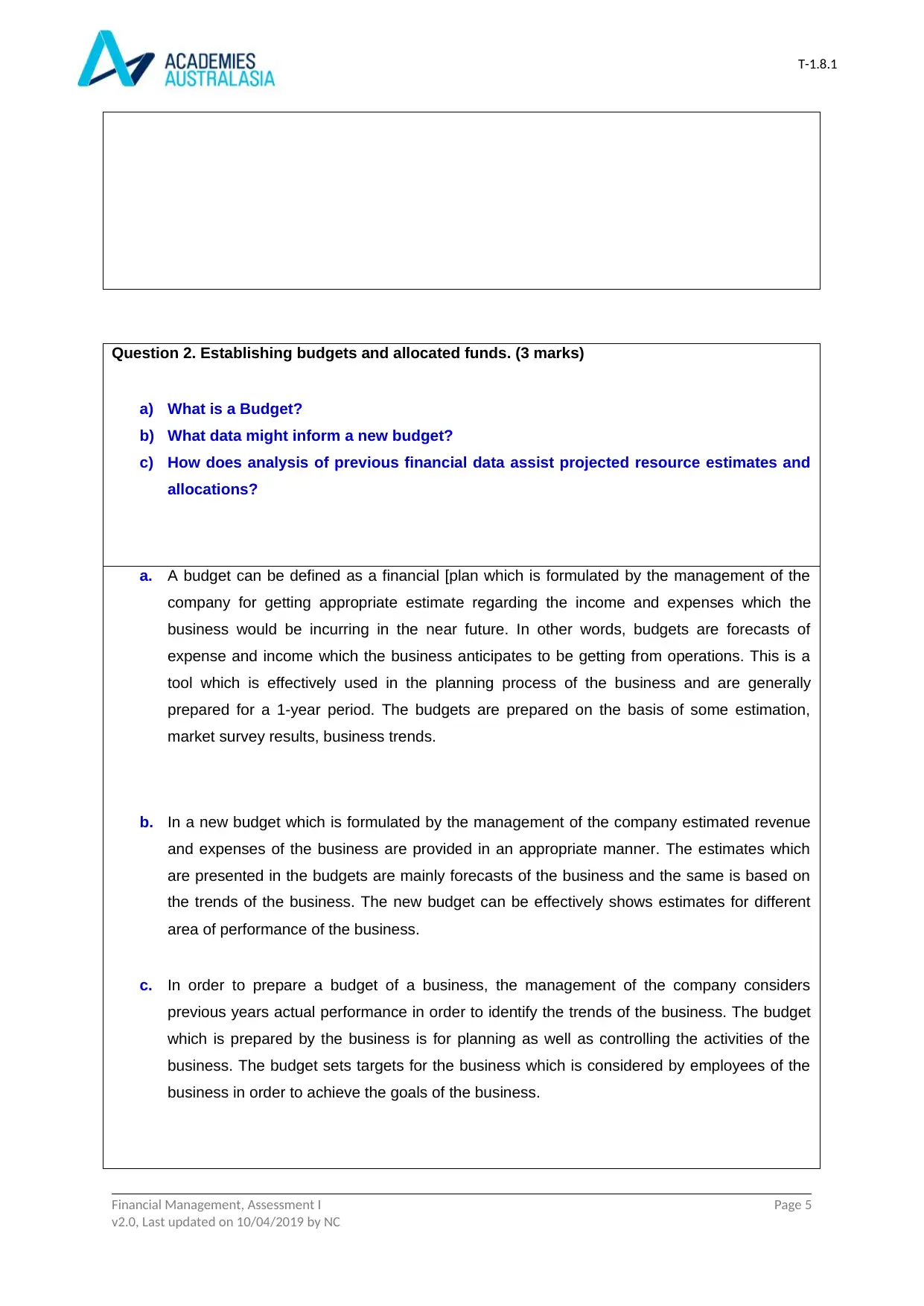
T-1.8.1
Question 2. Establishing budgets and allocated funds. (3 marks)
a) What is a Budget?
b) What data might inform a new budget?
c) How does analysis of previous financial data assist projected resource estimates and
allocations?
a. A budget can be defined as a financial [plan which is formulated by the management of the
company for getting appropriate estimate regarding the income and expenses which the
business would be incurring in the near future. In other words, budgets are forecasts of
expense and income which the business anticipates to be getting from operations. This is a
tool which is effectively used in the planning process of the business and are generally
prepared for a 1-year period. The budgets are prepared on the basis of some estimation,
market survey results, business trends.
b. In a new budget which is formulated by the management of the company estimated revenue
and expenses of the business are provided in an appropriate manner. The estimates which
are presented in the budgets are mainly forecasts of the business and the same is based on
the trends of the business. The new budget can be effectively shows estimates for different
area of performance of the business.
c. In order to prepare a budget of a business, the management of the company considers
previous years actual performance in order to identify the trends of the business. The budget
which is prepared by the business is for planning as well as controlling the activities of the
business. The budget sets targets for the business which is considered by employees of the
business in order to achieve the goals of the business.
Financial Management, Assessment I Page 5
v2.0, Last updated on 10/04/2019 by NC
Question 2. Establishing budgets and allocated funds. (3 marks)
a) What is a Budget?
b) What data might inform a new budget?
c) How does analysis of previous financial data assist projected resource estimates and
allocations?
a. A budget can be defined as a financial [plan which is formulated by the management of the
company for getting appropriate estimate regarding the income and expenses which the
business would be incurring in the near future. In other words, budgets are forecasts of
expense and income which the business anticipates to be getting from operations. This is a
tool which is effectively used in the planning process of the business and are generally
prepared for a 1-year period. The budgets are prepared on the basis of some estimation,
market survey results, business trends.
b. In a new budget which is formulated by the management of the company estimated revenue
and expenses of the business are provided in an appropriate manner. The estimates which
are presented in the budgets are mainly forecasts of the business and the same is based on
the trends of the business. The new budget can be effectively shows estimates for different
area of performance of the business.
c. In order to prepare a budget of a business, the management of the company considers
previous years actual performance in order to identify the trends of the business. The budget
which is prepared by the business is for planning as well as controlling the activities of the
business. The budget sets targets for the business which is considered by employees of the
business in order to achieve the goals of the business.
Financial Management, Assessment I Page 5
v2.0, Last updated on 10/04/2019 by NC
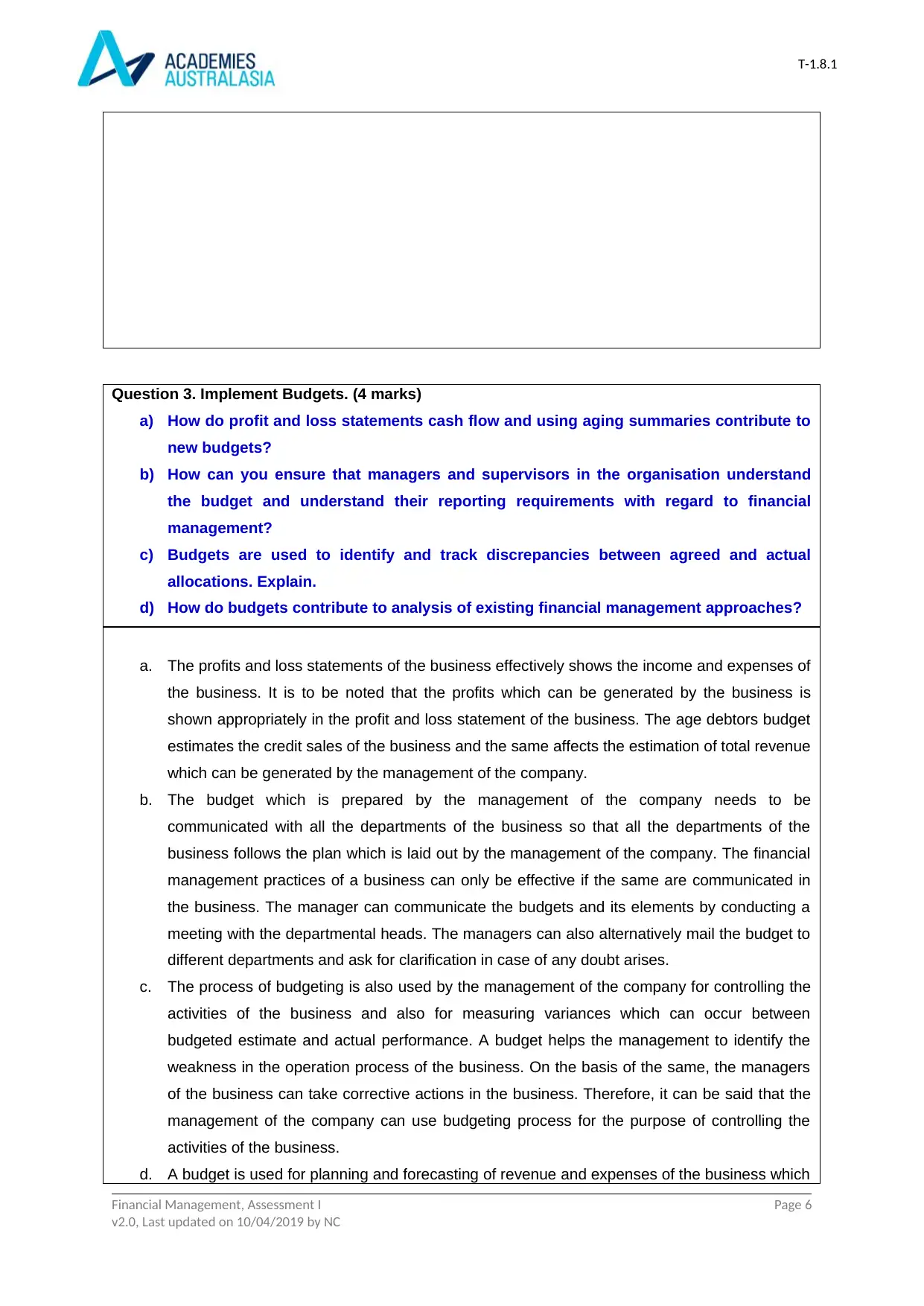
T-1.8.1
Question 3. Implement Budgets. (4 marks)
a) How do profit and loss statements cash flow and using aging summaries contribute to
new budgets?
b) How can you ensure that managers and supervisors in the organisation understand
the budget and understand their reporting requirements with regard to financial
management?
c) Budgets are used to identify and track discrepancies between agreed and actual
allocations. Explain.
d) How do budgets contribute to analysis of existing financial management approaches?
a. The profits and loss statements of the business effectively shows the income and expenses of
the business. It is to be noted that the profits which can be generated by the business is
shown appropriately in the profit and loss statement of the business. The age debtors budget
estimates the credit sales of the business and the same affects the estimation of total revenue
which can be generated by the management of the company.
b. The budget which is prepared by the management of the company needs to be
communicated with all the departments of the business so that all the departments of the
business follows the plan which is laid out by the management of the company. The financial
management practices of a business can only be effective if the same are communicated in
the business. The manager can communicate the budgets and its elements by conducting a
meeting with the departmental heads. The managers can also alternatively mail the budget to
different departments and ask for clarification in case of any doubt arises.
c. The process of budgeting is also used by the management of the company for controlling the
activities of the business and also for measuring variances which can occur between
budgeted estimate and actual performance. A budget helps the management to identify the
weakness in the operation process of the business. On the basis of the same, the managers
of the business can take corrective actions in the business. Therefore, it can be said that the
management of the company can use budgeting process for the purpose of controlling the
activities of the business.
d. A budget is used for planning and forecasting of revenue and expenses of the business which
Financial Management, Assessment I Page 6
v2.0, Last updated on 10/04/2019 by NC
Question 3. Implement Budgets. (4 marks)
a) How do profit and loss statements cash flow and using aging summaries contribute to
new budgets?
b) How can you ensure that managers and supervisors in the organisation understand
the budget and understand their reporting requirements with regard to financial
management?
c) Budgets are used to identify and track discrepancies between agreed and actual
allocations. Explain.
d) How do budgets contribute to analysis of existing financial management approaches?
a. The profits and loss statements of the business effectively shows the income and expenses of
the business. It is to be noted that the profits which can be generated by the business is
shown appropriately in the profit and loss statement of the business. The age debtors budget
estimates the credit sales of the business and the same affects the estimation of total revenue
which can be generated by the management of the company.
b. The budget which is prepared by the management of the company needs to be
communicated with all the departments of the business so that all the departments of the
business follows the plan which is laid out by the management of the company. The financial
management practices of a business can only be effective if the same are communicated in
the business. The manager can communicate the budgets and its elements by conducting a
meeting with the departmental heads. The managers can also alternatively mail the budget to
different departments and ask for clarification in case of any doubt arises.
c. The process of budgeting is also used by the management of the company for controlling the
activities of the business and also for measuring variances which can occur between
budgeted estimate and actual performance. A budget helps the management to identify the
weakness in the operation process of the business. On the basis of the same, the managers
of the business can take corrective actions in the business. Therefore, it can be said that the
management of the company can use budgeting process for the purpose of controlling the
activities of the business.
d. A budget is used for planning and forecasting of revenue and expenses of the business which
Financial Management, Assessment I Page 6
v2.0, Last updated on 10/04/2019 by NC
⊘ This is a preview!⊘
Do you want full access?
Subscribe today to unlock all pages.

Trusted by 1+ million students worldwide
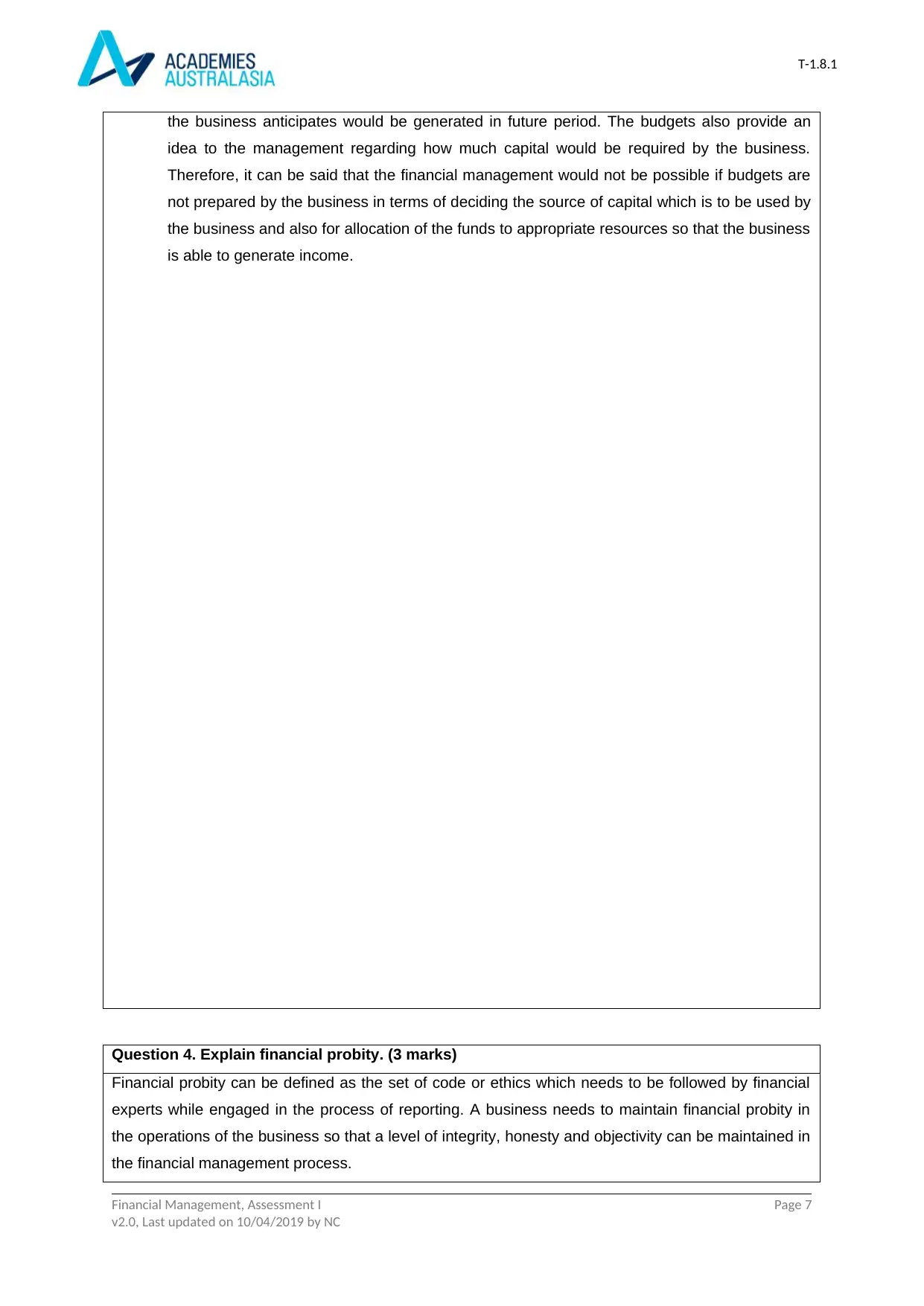
T-1.8.1
the business anticipates would be generated in future period. The budgets also provide an
idea to the management regarding how much capital would be required by the business.
Therefore, it can be said that the financial management would not be possible if budgets are
not prepared by the business in terms of deciding the source of capital which is to be used by
the business and also for allocation of the funds to appropriate resources so that the business
is able to generate income.
Question 4. Explain financial probity. (3 marks)
Financial probity can be defined as the set of code or ethics which needs to be followed by financial
experts while engaged in the process of reporting. A business needs to maintain financial probity in
the operations of the business so that a level of integrity, honesty and objectivity can be maintained in
the financial management process.
Financial Management, Assessment I Page 7
v2.0, Last updated on 10/04/2019 by NC
the business anticipates would be generated in future period. The budgets also provide an
idea to the management regarding how much capital would be required by the business.
Therefore, it can be said that the financial management would not be possible if budgets are
not prepared by the business in terms of deciding the source of capital which is to be used by
the business and also for allocation of the funds to appropriate resources so that the business
is able to generate income.
Question 4. Explain financial probity. (3 marks)
Financial probity can be defined as the set of code or ethics which needs to be followed by financial
experts while engaged in the process of reporting. A business needs to maintain financial probity in
the operations of the business so that a level of integrity, honesty and objectivity can be maintained in
the financial management process.
Financial Management, Assessment I Page 7
v2.0, Last updated on 10/04/2019 by NC
Paraphrase This Document
Need a fresh take? Get an instant paraphrase of this document with our AI Paraphraser
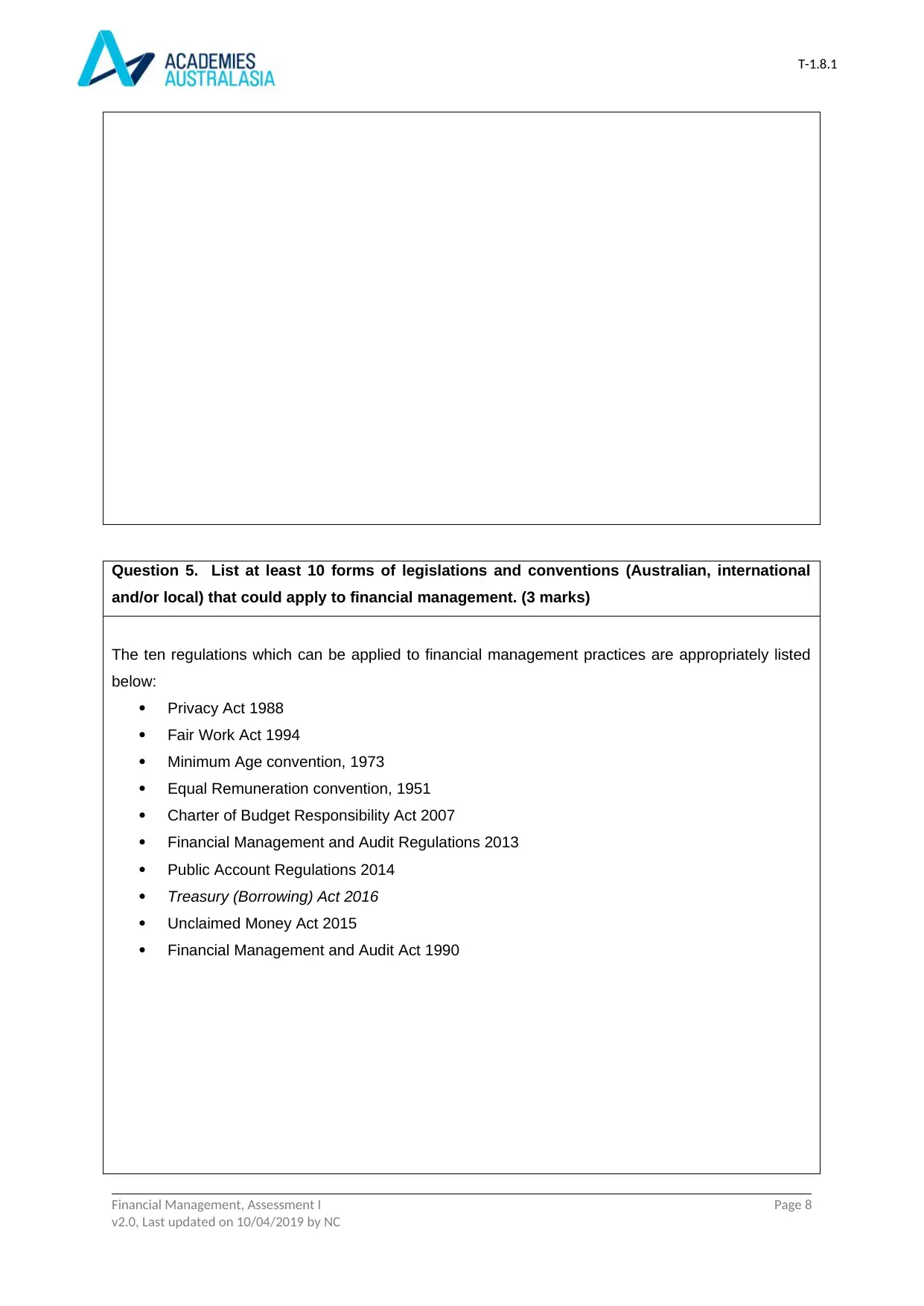
T-1.8.1
Question 5. List at least 10 forms of legislations and conventions (Australian, international
and/or local) that could apply to financial management. (3 marks)
The ten regulations which can be applied to financial management practices are appropriately listed
below:
Privacy Act 1988
Fair Work Act 1994
Minimum Age convention, 1973
Equal Remuneration convention, 1951
Charter of Budget Responsibility Act 2007
Financial Management and Audit Regulations 2013
Public Account Regulations 2014
Treasury (Borrowing) Act 2016
Unclaimed Money Act 2015
Financial Management and Audit Act 1990
Financial Management, Assessment I Page 8
v2.0, Last updated on 10/04/2019 by NC
Question 5. List at least 10 forms of legislations and conventions (Australian, international
and/or local) that could apply to financial management. (3 marks)
The ten regulations which can be applied to financial management practices are appropriately listed
below:
Privacy Act 1988
Fair Work Act 1994
Minimum Age convention, 1973
Equal Remuneration convention, 1951
Charter of Budget Responsibility Act 2007
Financial Management and Audit Regulations 2013
Public Account Regulations 2014
Treasury (Borrowing) Act 2016
Unclaimed Money Act 2015
Financial Management and Audit Act 1990
Financial Management, Assessment I Page 8
v2.0, Last updated on 10/04/2019 by NC
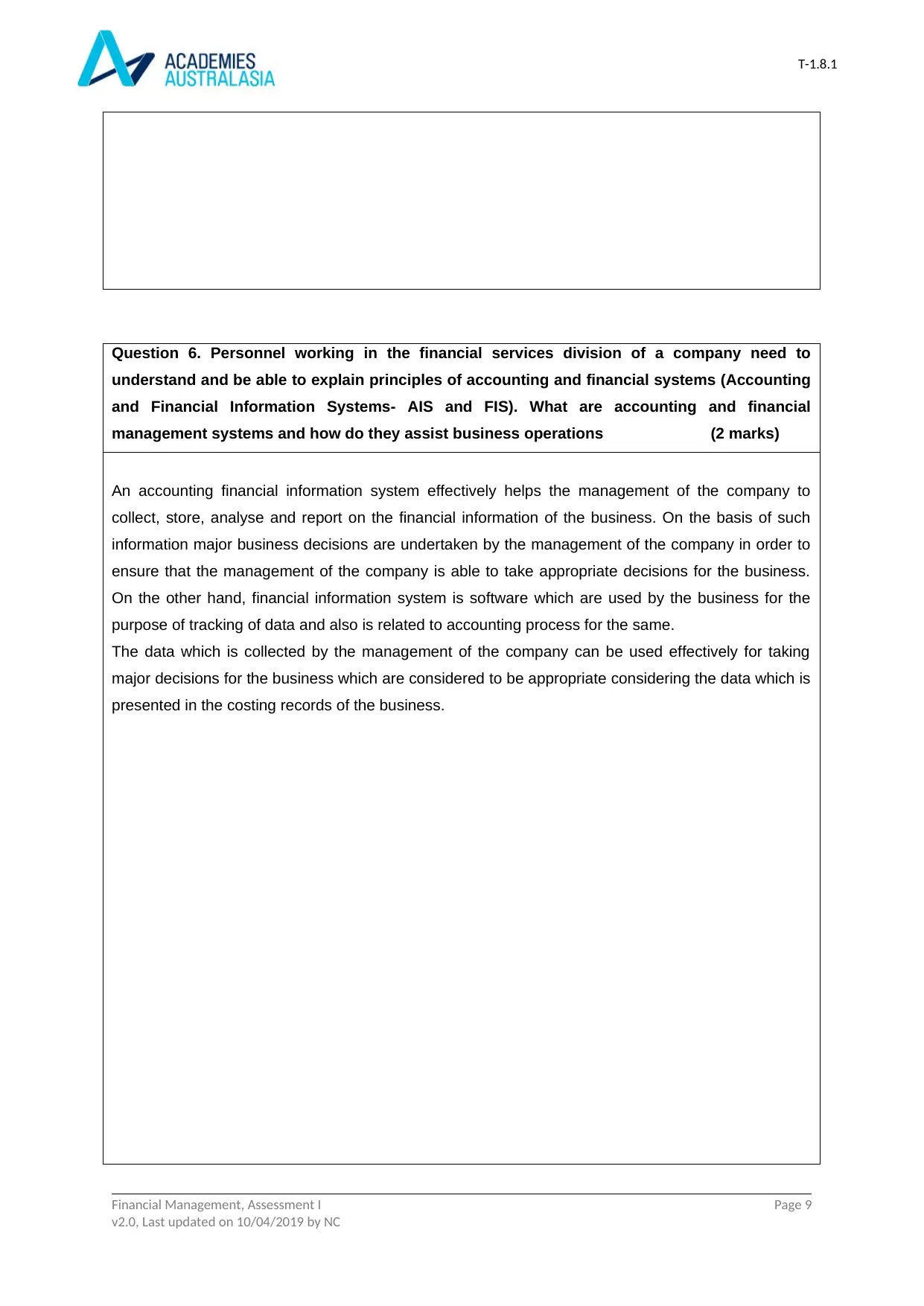
T-1.8.1
Question 6. Personnel working in the financial services division of a company need to
understand and be able to explain principles of accounting and financial systems (Accounting
and Financial Information Systems- AIS and FIS). What are accounting and financial
management systems and how do they assist business operations (2 marks)
An accounting financial information system effectively helps the management of the company to
collect, store, analyse and report on the financial information of the business. On the basis of such
information major business decisions are undertaken by the management of the company in order to
ensure that the management of the company is able to take appropriate decisions for the business.
On the other hand, financial information system is software which are used by the business for the
purpose of tracking of data and also is related to accounting process for the same.
The data which is collected by the management of the company can be used effectively for taking
major decisions for the business which are considered to be appropriate considering the data which is
presented in the costing records of the business.
Financial Management, Assessment I Page 9
v2.0, Last updated on 10/04/2019 by NC
Question 6. Personnel working in the financial services division of a company need to
understand and be able to explain principles of accounting and financial systems (Accounting
and Financial Information Systems- AIS and FIS). What are accounting and financial
management systems and how do they assist business operations (2 marks)
An accounting financial information system effectively helps the management of the company to
collect, store, analyse and report on the financial information of the business. On the basis of such
information major business decisions are undertaken by the management of the company in order to
ensure that the management of the company is able to take appropriate decisions for the business.
On the other hand, financial information system is software which are used by the business for the
purpose of tracking of data and also is related to accounting process for the same.
The data which is collected by the management of the company can be used effectively for taking
major decisions for the business which are considered to be appropriate considering the data which is
presented in the costing records of the business.
Financial Management, Assessment I Page 9
v2.0, Last updated on 10/04/2019 by NC
⊘ This is a preview!⊘
Do you want full access?
Subscribe today to unlock all pages.

Trusted by 1+ million students worldwide
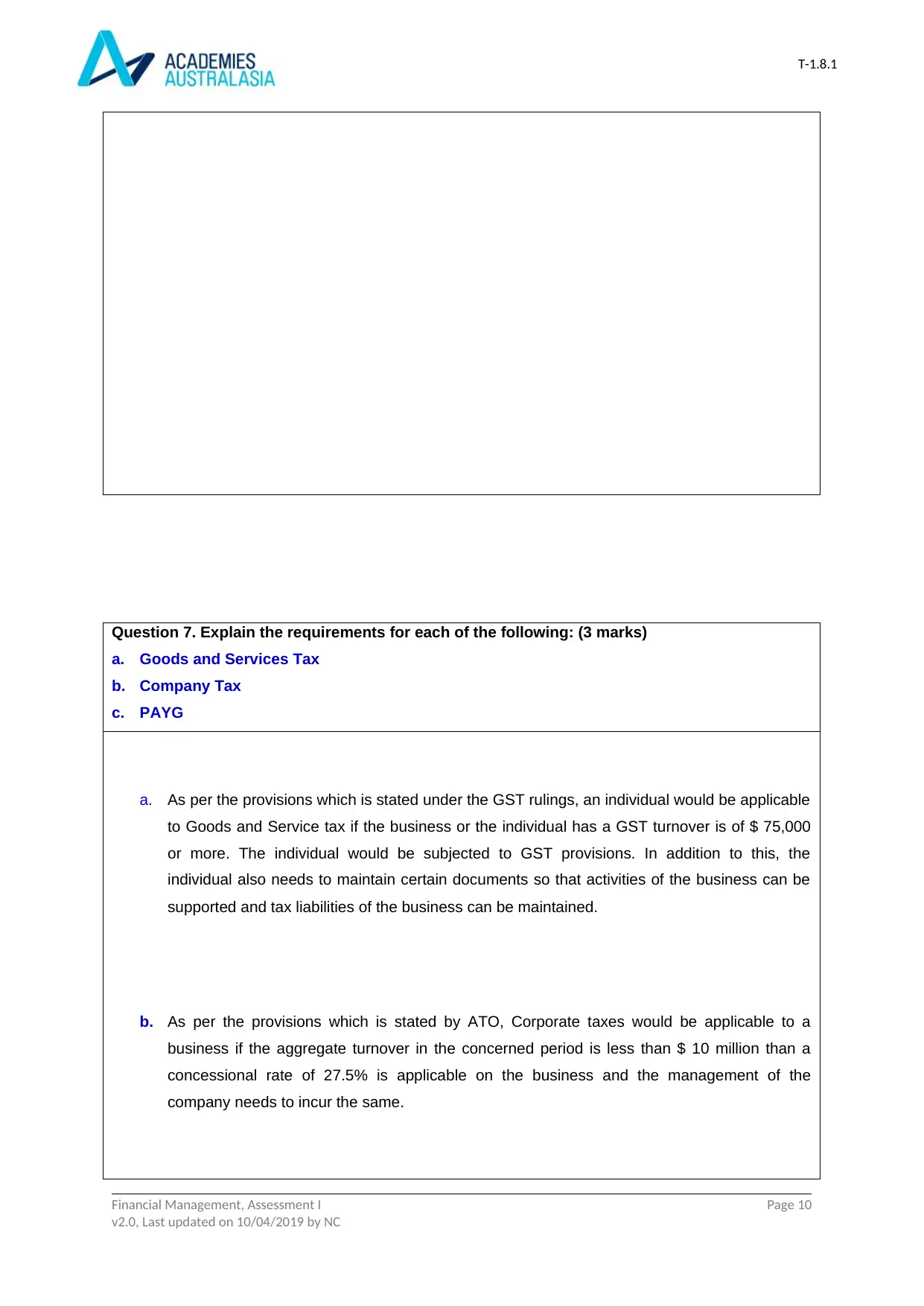
T-1.8.1
Question 7. Explain the requirements for each of the following: (3 marks)
a. Goods and Services Tax
b. Company Tax
c. PAYG
a. As per the provisions which is stated under the GST rulings, an individual would be applicable
to Goods and Service tax if the business or the individual has a GST turnover is of $ 75,000
or more. The individual would be subjected to GST provisions. In addition to this, the
individual also needs to maintain certain documents so that activities of the business can be
supported and tax liabilities of the business can be maintained.
b. As per the provisions which is stated by ATO, Corporate taxes would be applicable to a
business if the aggregate turnover in the concerned period is less than $ 10 million than a
concessional rate of 27.5% is applicable on the business and the management of the
company needs to incur the same.
Financial Management, Assessment I Page 10
v2.0, Last updated on 10/04/2019 by NC
Question 7. Explain the requirements for each of the following: (3 marks)
a. Goods and Services Tax
b. Company Tax
c. PAYG
a. As per the provisions which is stated under the GST rulings, an individual would be applicable
to Goods and Service tax if the business or the individual has a GST turnover is of $ 75,000
or more. The individual would be subjected to GST provisions. In addition to this, the
individual also needs to maintain certain documents so that activities of the business can be
supported and tax liabilities of the business can be maintained.
b. As per the provisions which is stated by ATO, Corporate taxes would be applicable to a
business if the aggregate turnover in the concerned period is less than $ 10 million than a
concessional rate of 27.5% is applicable on the business and the management of the
company needs to incur the same.
Financial Management, Assessment I Page 10
v2.0, Last updated on 10/04/2019 by NC
Paraphrase This Document
Need a fresh take? Get an instant paraphrase of this document with our AI Paraphraser
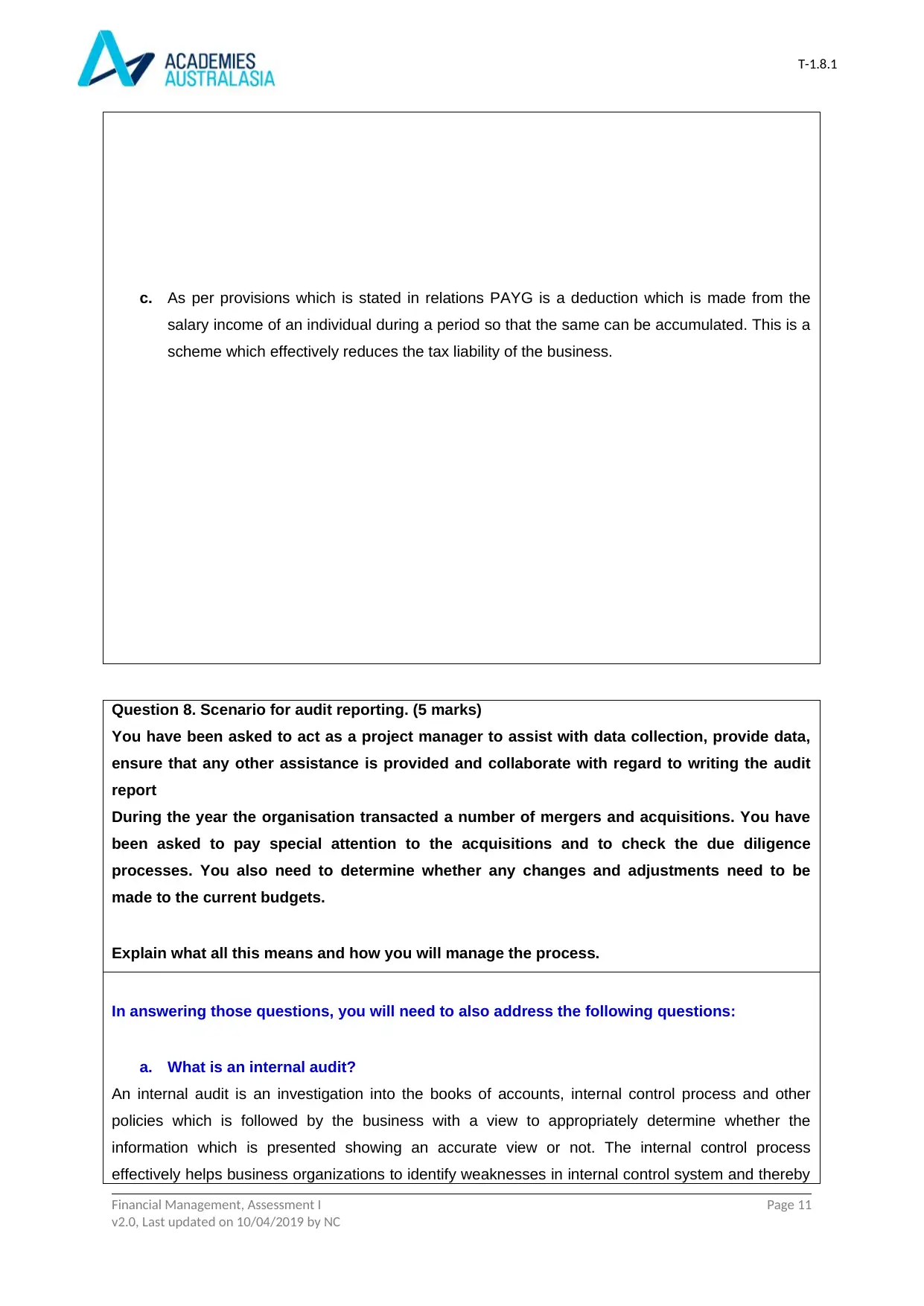
T-1.8.1
c. As per provisions which is stated in relations PAYG is a deduction which is made from the
salary income of an individual during a period so that the same can be accumulated. This is a
scheme which effectively reduces the tax liability of the business.
Question 8. Scenario for audit reporting. (5 marks)
You have been asked to act as a project manager to assist with data collection, provide data,
ensure that any other assistance is provided and collaborate with regard to writing the audit
report
During the year the organisation transacted a number of mergers and acquisitions. You have
been asked to pay special attention to the acquisitions and to check the due diligence
processes. You also need to determine whether any changes and adjustments need to be
made to the current budgets.
Explain what all this means and how you will manage the process.
In answering those questions, you will need to also address the following questions:
a. What is an internal audit?
An internal audit is an investigation into the books of accounts, internal control process and other
policies which is followed by the business with a view to appropriately determine whether the
information which is presented showing an accurate view or not. The internal control process
effectively helps business organizations to identify weaknesses in internal control system and thereby
Financial Management, Assessment I Page 11
v2.0, Last updated on 10/04/2019 by NC
c. As per provisions which is stated in relations PAYG is a deduction which is made from the
salary income of an individual during a period so that the same can be accumulated. This is a
scheme which effectively reduces the tax liability of the business.
Question 8. Scenario for audit reporting. (5 marks)
You have been asked to act as a project manager to assist with data collection, provide data,
ensure that any other assistance is provided and collaborate with regard to writing the audit
report
During the year the organisation transacted a number of mergers and acquisitions. You have
been asked to pay special attention to the acquisitions and to check the due diligence
processes. You also need to determine whether any changes and adjustments need to be
made to the current budgets.
Explain what all this means and how you will manage the process.
In answering those questions, you will need to also address the following questions:
a. What is an internal audit?
An internal audit is an investigation into the books of accounts, internal control process and other
policies which is followed by the business with a view to appropriately determine whether the
information which is presented showing an accurate view or not. The internal control process
effectively helps business organizations to identify weaknesses in internal control system and thereby
Financial Management, Assessment I Page 11
v2.0, Last updated on 10/04/2019 by NC
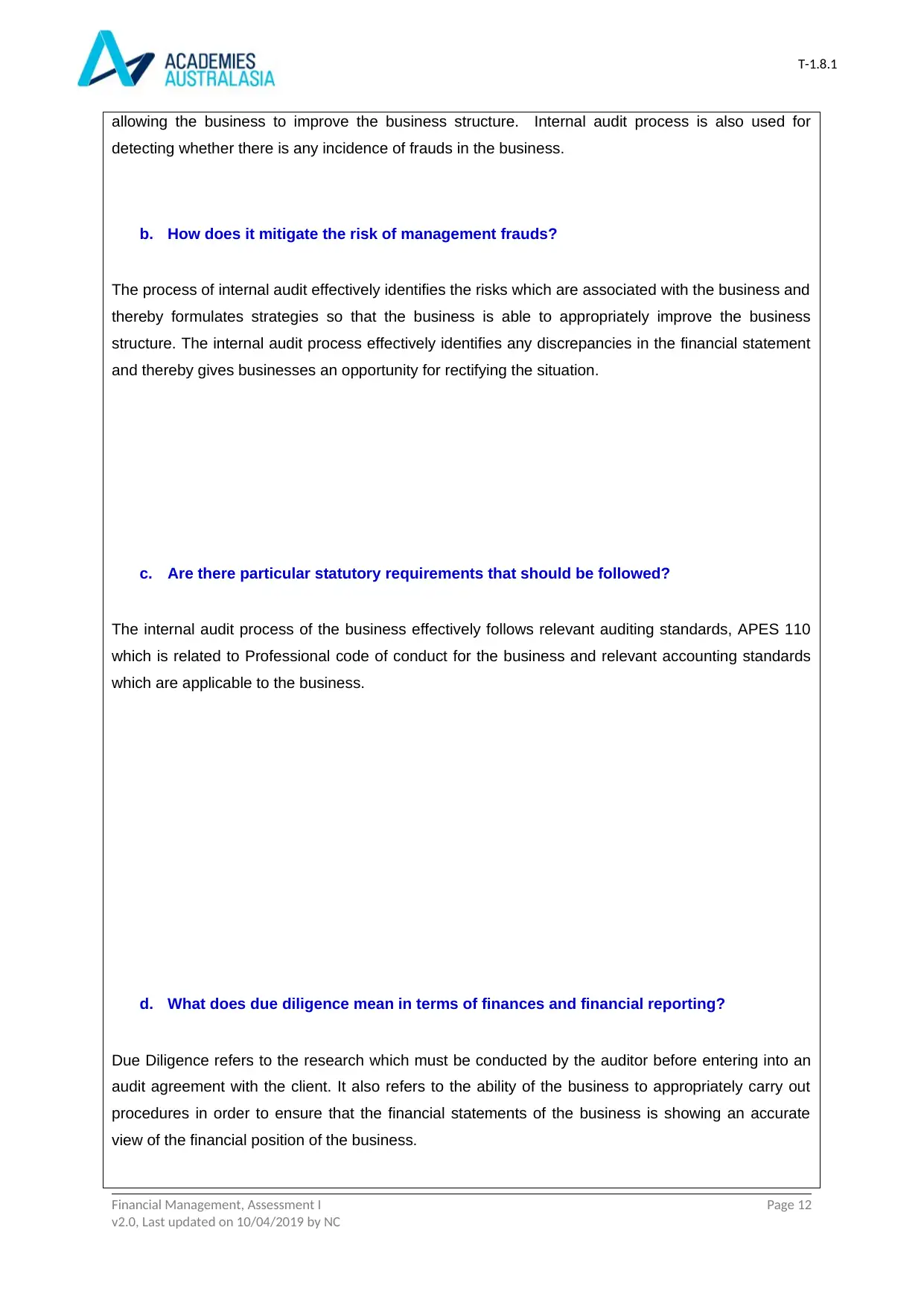
T-1.8.1
allowing the business to improve the business structure. Internal audit process is also used for
detecting whether there is any incidence of frauds in the business.
b. How does it mitigate the risk of management frauds?
The process of internal audit effectively identifies the risks which are associated with the business and
thereby formulates strategies so that the business is able to appropriately improve the business
structure. The internal audit process effectively identifies any discrepancies in the financial statement
and thereby gives businesses an opportunity for rectifying the situation.
c. Are there particular statutory requirements that should be followed?
The internal audit process of the business effectively follows relevant auditing standards, APES 110
which is related to Professional code of conduct for the business and relevant accounting standards
which are applicable to the business.
d. What does due diligence mean in terms of finances and financial reporting?
Due Diligence refers to the research which must be conducted by the auditor before entering into an
audit agreement with the client. It also refers to the ability of the business to appropriately carry out
procedures in order to ensure that the financial statements of the business is showing an accurate
view of the financial position of the business.
Financial Management, Assessment I Page 12
v2.0, Last updated on 10/04/2019 by NC
allowing the business to improve the business structure. Internal audit process is also used for
detecting whether there is any incidence of frauds in the business.
b. How does it mitigate the risk of management frauds?
The process of internal audit effectively identifies the risks which are associated with the business and
thereby formulates strategies so that the business is able to appropriately improve the business
structure. The internal audit process effectively identifies any discrepancies in the financial statement
and thereby gives businesses an opportunity for rectifying the situation.
c. Are there particular statutory requirements that should be followed?
The internal audit process of the business effectively follows relevant auditing standards, APES 110
which is related to Professional code of conduct for the business and relevant accounting standards
which are applicable to the business.
d. What does due diligence mean in terms of finances and financial reporting?
Due Diligence refers to the research which must be conducted by the auditor before entering into an
audit agreement with the client. It also refers to the ability of the business to appropriately carry out
procedures in order to ensure that the financial statements of the business is showing an accurate
view of the financial position of the business.
Financial Management, Assessment I Page 12
v2.0, Last updated on 10/04/2019 by NC
⊘ This is a preview!⊘
Do you want full access?
Subscribe today to unlock all pages.

Trusted by 1+ million students worldwide
1 out of 27
Related Documents
Your All-in-One AI-Powered Toolkit for Academic Success.
+13062052269
info@desklib.com
Available 24*7 on WhatsApp / Email
![[object Object]](/_next/static/media/star-bottom.7253800d.svg)
Unlock your academic potential
Copyright © 2020–2025 A2Z Services. All Rights Reserved. Developed and managed by ZUCOL.





